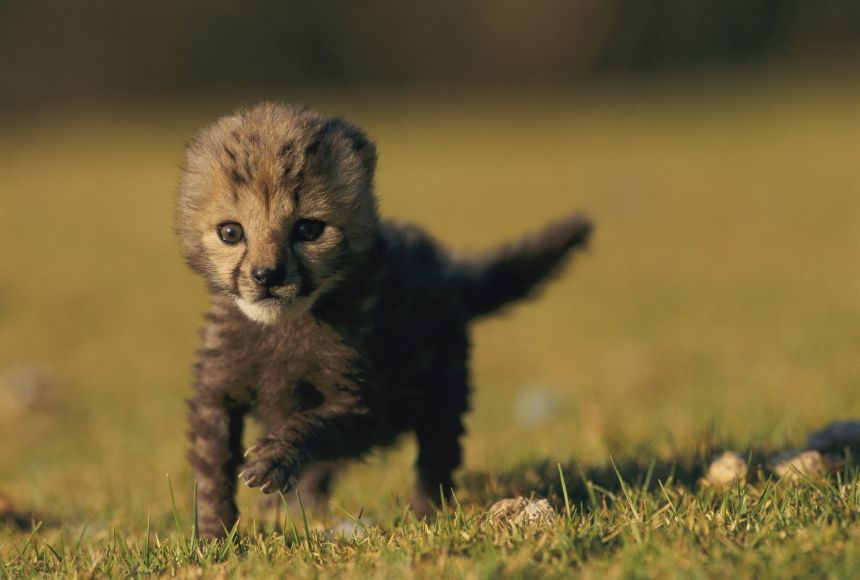Cheetahs (Acinonyx jubatus) are cats that can sprint at speeds of about 120 kilometers per hour (75 miles per hour). They can accelerate from 0 to 97 kilometers per hour (60 miles per hour) in three seconds. That's faster than most sports cars! Cheetahs use their acceleration and speed to chase down and catch their prey. Cheetahs have small heads, lean bodies, and long legs. They have a yellowish-tan coat with distinctive black spots. Many live in captivity, but others live on the savannas of sub-Saharan Africa. Another small population lives in Iran.
Cheetahs face extinction pressure from climate change, hunting by humans, and habitat destruction. Cheetahs also have a low rate of reproductive success. When a population has fewer offspring, it's harder for it to grow.
Evolution of Cheetahs
There are various theories about cheetah evolution. Some experts believe cheetahs descended from the same ancestor as the American puma (Puma concolor). About 10,000 to 12,000 years ago, around the end of the last ice age, an extinction event wiped out many large mammal species. The wild cheetahs of North America and Europe went extinct. This left only the Asian and African populations of cheetahs. Since then, stress from climate change, habitat loss, and human activities have put pressure on the remaining animals. Today, cheetahs are found in the wild in several locations in Africa and a small portion of Iran. Scientists estimate that fewer than 8,000 African cheetahs are living in the wild. There are even fewer Asian cheetahs left, reportedly only about 50.
Bottleneck Events
Cheetahs today are heading toward extinction. However, this is not the first time they have faced extinction. Genetic analysis of wild cheetahs shows they may have survived two bottleneck events. The term "bottleneck event" refers to something that sharply reduces the size of a population. When this happens, the few remaining individuals end up mating with relatives; this process is called inbreeding. Inbreeding reduces the size of the gene pool, which can decrease genetic variability. Lower genetic variability makes it harder for the population to adapt to changes in its environment. In small populations, mutations can be passed down through the generations more easily.
The first bottleneck event cheetahs may have undergone occurred around 100,000 years ago when they expanded into Asia, Europe, and Africa. This expansion is believed to have occurred rapidly, dispersing cheetahs over a very large area, thus restricting their ability to exchange genes.
The second likely bottleneck event occurred about 10,000 to 12,000 years ago. That's about when the last ice age ended. The wild cheetahs of North America and Europe went extinct. The Asian and African populations were all that remained. As large mammals died out across the world, the number of surviving cheetahs dwindled. This led to extreme inbreeding. Even though the number of cheetahs grew to as many as 100,000 during the 19th century, their genetic variability remained low due to the bottleneck event of millennia before.
Cheetah Genes Today
Cheetah populations today have relatively low genetic variability. One way to test for inbreeding is to perform a skin graft. This involves transplanting a piece of skin from one cheetah to another. In inbred populations, skin grafts are easily accepted by individuals unrelated to the donor. This occurs among cheetahs, suggesting they have lost some genetic diversity. Another sign of inbreeding are asymmetrical skulls. In inbred animals, the skull is more asymmetrical. This is true of cheetah skulls in select museum collections.
Further evidence for inbreeding comes from cheetahs’ high homozygosity. Homozygosity is a measure of the genetic similarity between individuals in a population. Cheetah genomes typically exceed 90 percent homozygosity. By contrast, domestic cats (Felis catus) and dogs (Canis lupus familiaris), while also commonly inbred, have significantly lower rates of homozygosity.
Cheetahs are facing several threats. These threats are collectively pushing them toward extinction. Humans are threatening the species by infringing on their habitat and perpetuating climate change. Human hunting of cheetahs has also reduced the species' numbers. Experts believe cheetahs may also suffer from infectious diseases spread by domestic cats. Cheetahs struggle to cope in part because they lack genetic variability. Evidence suggests cheetahs have faced genetic bottlenecks in the past and survived. As the population of wild cheetahs dwindles again, only time will tell if it can survive the current genetic bottleneck.
